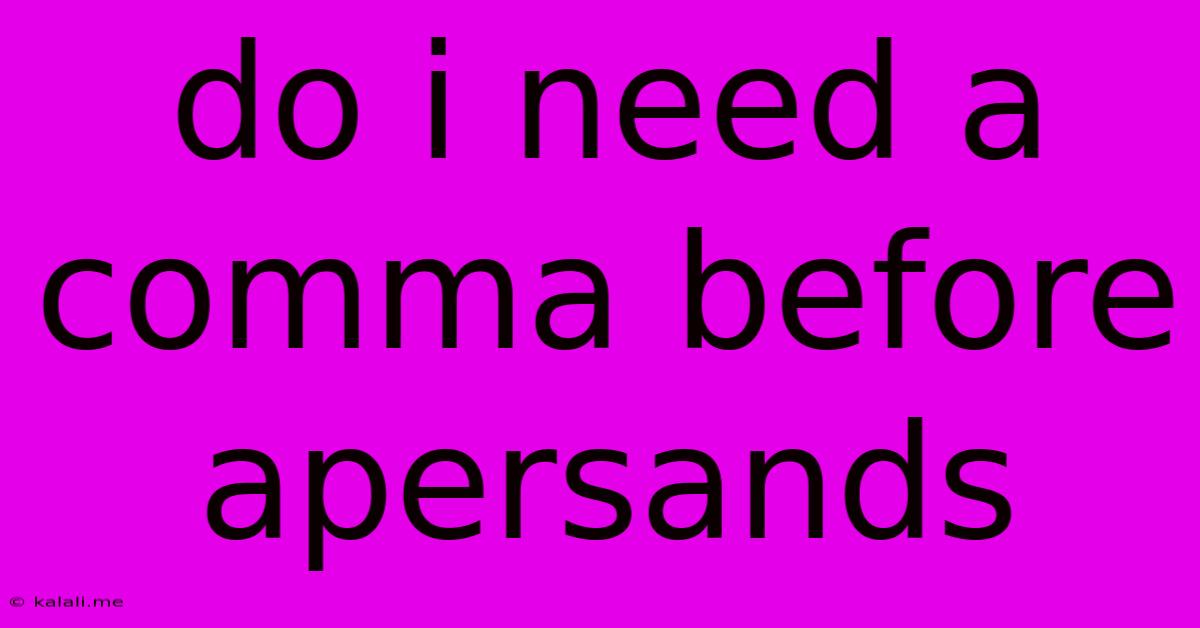Do I Need A Comma Before Apersands
Kalali
May 24, 2025 · 2 min read

Table of Contents
Do I Need a Comma Before an Ampersand? A Style Guide for Clarity and Consistency
The question of whether to use a comma before an ampersand (&) is a common one, sparking debates among writers and editors. The answer, unfortunately, isn't a simple yes or no. It depends heavily on context, style guide preferences, and the overall readability of your sentence. This guide will break down the rules and exceptions to help you make informed decisions about comma usage with ampersands.
Understanding the Role of the Ampersand
The ampersand (&) is a ligature representing the word "and." Its use often signifies a more informal or stylistic choice compared to explicitly writing "and." This informality impacts the punctuation rules surrounding it.
The General Rule: Context is King
There's no universally accepted grammatical rule mandating a comma before an ampersand. Instead, the decision hinges on the grammatical function of the ampersand within the sentence. Consider these scenarios:
When to Use a Comma Before an Ampersand
-
In lists of three or more items: When using an ampersand to connect the final two items in a series, a comma typically precedes the ampersand. This enhances clarity and prevents ambiguity.
Example: "I bought apples, bananas, and oranges." becomes "I bought apples, bananas & oranges."
-
When joining lengthy phrases or clauses: If the items connected by the ampersand are long or complex, using a comma improves readability. This avoids creating a visually overwhelming sentence.
Example: "The conference brought together experts in data science, machine learning, and artificial intelligence & deep learning techniques."
When to Omit the Comma Before an Ampersand
-
In short, simple lists: With short and simple lists, omitting the comma before the ampersand is often acceptable. The brevity makes the sentence easily understandable without additional punctuation.
Example: "I need milk & bread."
-
In company names and trademarks: Company names and trademarks often use the ampersand without surrounding commas, reflecting established branding conventions.
Example: "Smith & Jones LLP"
-
When the ampersand connects two single words acting as a single compound term: In some cases, the ampersand unites two words to form a single unit. A comma would be inappropriate here.
Example: "Rock & Roll" (not Rock & , Roll)
Style Guide Considerations
Different style guides may have their own preferences regarding comma usage with ampersands. Familiarize yourself with the style guide relevant to your writing (e.g., AP Stylebook, Chicago Manual of Style). Consistency is key; adhere to the chosen style guide throughout your work.
Prioritizing Readability
Ultimately, the most important factor is readability. Choose the punctuation that makes your sentence clearest and easiest to understand. If a comma improves comprehension, use it; if it adds unnecessary complexity, omit it.
In Conclusion
The comma before an ampersand isn't governed by a rigid rule. Context, style guide adherence, and the need for clear communication are the deciding factors. By carefully considering these aspects, you can effectively and consistently use ampersands in your writing. Focus on crafting clear and easily understandable sentences, and let that guide your punctuation choices.
Latest Posts
Latest Posts
-
Knight And Maid Murder The Monarchs And Have An Affair
May 25, 2025
-
Being A Baby Feels Great Logo
May 25, 2025
-
Is Not Utf 8 Encoded Falling Back To Latin1
May 25, 2025
-
Car Has Power But Wont Start No Click
May 25, 2025
-
Ncrete Mathematics A Foundation For Computer Science Prerequisties
May 25, 2025
Related Post
Thank you for visiting our website which covers about Do I Need A Comma Before Apersands . We hope the information provided has been useful to you. Feel free to contact us if you have any questions or need further assistance. See you next time and don't miss to bookmark.